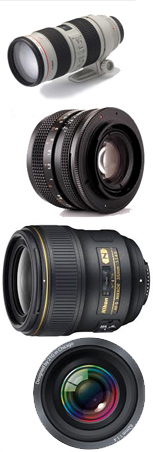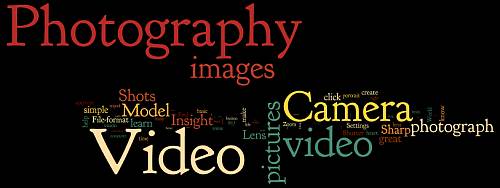
• Lenses •
Buying lenses optimised for your sensor is confusing.
Lenses are a big investment…
It is difficult to know which lens is optimised for your digital image sensor. There seems to be so many different designations. Here is a guide to which lens designation you want.
Explaining the differences
Brands like Canon and Nikon have their own lenses range. Third party manufacturers, like Sigma, Tokina and Tamron etc. manufacture lenses for brands like Nikon, Canon and others. if buying lenses the third party manufacturers have lenses which are equivalent to the Camera brand manufacturer or possibly better. Look around at online reviews to see what standard of lenses and prices are available.
Make sure you buy lenses fitted with the correct lens mount for your camera. Older models of cameras may have the correct mount but some of the more recent lenses might not be suitable to work with the camera. So check the mount and camera are compatible before buying.
Why are lens mounts specific to brands? It’s mainly historical – the development paths of the manufacturers differ. However, they also want their customers to stay loyal to the brand. This unfortunate situation means you have to reinvest in a new range of lenses if you change your camera body. Hmmm! Expensive.
There are two types of camera sensor. There are cropped sensors – which is a small size. These are more often referred to as APS-C format.
The other sensor format is full frame sensor. These are the size equivalent of the old film SLR frames on a roll of film.
Full frame digital sensors are less common than cropped sensors. The cropped sensors are easier and cheaper to manufacture. However, in recent years we are seeing an increase in full frame releases of new cameras. The higher resolution (more pixels) and potentially bigger print sizes are attractive to consumers. As full frame format gets cheaper they are likely to become more common.
The full frame sensor size is the same size as a 35 mm (36mm ×24mm) film frame in old SLR cameras. Because of the historical significance of the 35mm format modern DSLRs are based on the same standard. Lenses are normally designed to fit either the full frame format or the cropped format.
Lenses designed for the full frame sensor have an image circle that covers the whole 35mm sensor. These lenses tend to be more expensive because they need a wide circle of light thorough them to cover the sensor. They have bigger glass elements as a result.
Full-frame sized lenses are able to fit a camera with the same mount and a cropped sensor. The image circle from the lens remains constant. The smaller sensor size (APS-C) is therefore only able to process the light from the centre of the circle – the rest of the light spills over the side of the sensor. The resultant photograph is like a zoomed-in crop of the image that would have otherwise been taken with a full frame sensor.
This image-cropping effect of smaller sensors is known as the “crop factor”. It represents the ratio of the size of the full-frame 35 mm sensor to the size of the smaller format. The apparent zooming effect also gives rise to an alternative name – the “focal-length multiplier”.
The ratio of full-frame to crop tends to lie in the range 1.3–2.0 for most cropped sensor DSLRs. You might say that a 100 mm lens on a camera with a 1.5 crop factor creates an apparent zoom multiplying the focal length by 1.5. A 100mm lens would then appear to produce the same picture as a 150mm lens. This is not a true magnification since the focal length of the lens is the same on both cameras. Instead the cropped sensor is likely to produce a lower quality result than than the full frame sensor while revealing a closer result.
You can use lenses designed for full frame sensors on cropped sensors. It does not work the other way. A lens designed for a cropped sensor creates an image circle smaller than the full-frame sensor. It would create a circular image with very strong vignetting around the sides. Manufacturers recommend not using lenses designed for cropped sensors on full frame cameras.
Designations
To ensure that buyers purchase the correct lenses for full frame or cropped sensor manufacturers designate them with specific marques. Here is the breakdown of the most common designations…
| Manufacturer | Full frame (and APS-C) |
APS-C (cropped) |
|---|---|---|
| Canon | EF | pEF-S |
| Nikon | FX | DX |
| Sigma | DG | DC |
| Tokina | FX | DX |
| Sony | Various‑incl. 3rd party mounts |
DT |
| Tamron | Di | Di-II |
| Samsung | Not available‑2013 | NX |
| Pentax | Check manufacturer specification |
DA |
| Konica‑Minolta | Check manufacturer specification |
DT |
Other related sources…
Lens manufacturers (Wikipedia) ![]()
Photography equipment manufacturers (cameras, lenses etc) (Wikipedia) ![]()
Comments, additions, amendments or ideas on this article? Contact Us
Start Photokonnexion email subscription now!
Photokonnexion Photographic Glossary – Definitions and articles.
Definition: Lens designations/Marques; Full Frame designations; Brand lens designations
Definition: Sensor; Image Sensor; Digital Image Sensor
Definition: Lens Mount
Definition: SLR; Single Lens Reflex Camera
Definition: DSLR; Digital Single Lens Reflex Camera
Definition: Vignette; Vignetting
List of Lens manufacturers (Wikipedia)
List of List of photographic equipment manufacturers (incl. cameras, lenses etc) (Wikipedia)
 Photokonnexion tips by email
Photokonnexion tips by emailIf you enjoyed this article please sign up for our
Tips by email service.
Find out more…
We would love to have your articles or tips posted on our site.
Find out more…
Write for Photokonnexion.










